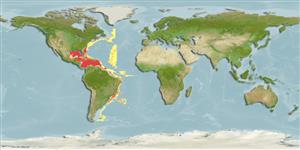Common names from other countries
>
Ophidiiformes (Cusk eels) >
Bythitidae (Livebearing brotulas)
Etymology: Barathronus: Greek, barathron = abyss + ending -ites, that lives there; the Barathron was a deep pit in Athens where criminals were thrown; 1849 +Greek, onos = hake.
More on authors: Goode & Bean.
Environment: milieu / climate zone / depth range / distribution range
экология
морской батипелагический; пределы глубины 366 - 3270 m (Ref. 121928), usually 366 - 1640 m (Ref. 34024). Deep-water
Western Central Atlantic: Gulf of Mexico and the Caribbean Sea.
Size / Вес / Возраст
Maturity: Lm ? range ? - ? cm
Max length : 14.0 cm SL самец/пол неопределен; (Ref. 121928)
Краткое описание
определительные ключи | морфология | морфометрия
членистые (мягкие) лучи спинного плавника (общее число) : 62 - 78; членистые (мягкие) лучи анального плавника: 46 - 59; позвонки: 68 - 75. Barathronus bicolor differs from the other five species of the genus with dark-pigmented peritoneum by the following combination of characters: D 62-78, A 46-59, pectoral-fin rays 22-27, anterior gill arch with 28-35 long rakers; vertebrae, precaudal 31-36, total 68-75; vomer with 1-5 fangs; paired bulbs at basis of penis not developed; no ventral flexure of anteriormost vertebrae; penis in ripe specimens long (up to 15% SL) and slender; fresh specimens light brownish with dark-blue peritoneum; otolith almost circular three times as long as thick and centrally placed sulcus 3-4 times in length of otolith (Ref. 121928).
Common species (Ref. 34024).
Life cycle and mating behavior
Maturities | размножение | Spawnings | Egg(s) | Fecundities | личинки
Nielsen, J.G., 2019. Revision of the circumglobal genus Barathronus (Ophidiiformes, Bythitidae) with a new species from the eastern North Atlantic Ocean. Zootaxa 4679(2):231-256. (Ref. 121928)
Статус Красного Списка МСОП (Ref. 130435)
CITES (Ref. 128078)
Not Evaluated
Угроза для людей
Harmless
Использование человеком
рыболовство: интереса не представляет
дополнительная информация
инструменты
Специальные отчеты
Скачать в формате XML
ресурсы в Интернет
Estimates based on models
Preferred temperature (Ref.
115969): 4.8 - 10.4, mean 6.3 (based on 143 cells).
Phylogenetic diversity index (Ref.
82804): PD
50 = 0.5005 [Uniqueness, from 0.5 = low to 2.0 = high].
Bayesian length-weight: a=0.00457 (0.00179 - 0.01169), b=3.10 (2.87 - 3.33), in cm Total Length, based on LWR estimates for this (Sub)family-body shape (Ref.
93245).
Trophic level (Ref.
69278): 3.4 ±0.5 se; based on size and trophs of closest relatives
устойчивость к внешним воздействиям (Ref.
120179): высокий, минимальное время удвоения популяции до 15 месяцев (Preliminary K or Fecundity.).
Fishing Vulnerability (Ref.
59153): Low vulnerability (10 of 100).
